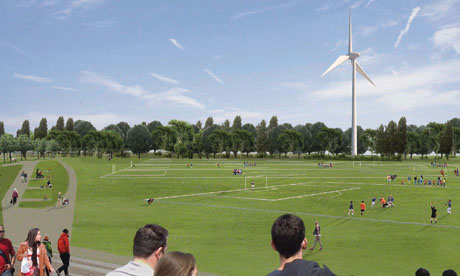Hackney’s wind turbine: a Mega what?

Artist's impression of the proposed wind turbine on Hackney Marshes
Hackney Council’s latest projection for the amount of electricity that could potentially be generated by Hackney’s east marsh wind turbine does not appear credible.
Council freesheet Hackney Today recently announced (7 June 2010) that the amount of power that could be generated by the wind turbine planned for East Marsh was estimated to be “… enough electricity to power two thirds of Hackney’s street lights”.
The turbine in question has a theoretical maximum output of 2MW, but engineers interviewed by the Hackney Marsh User (HMUG) group on 16 March this year are reported to have said that the “assumed actual power of each turbine (the ‘load factor’) is 22.8 per cent of the potential maximum of 2MW.”
According to my calculations, this means that the wind turbine on East Marsh could provide just 28.7 per cent of the power requirement of all of Hackney’s street lights – less than half of the amount that the Council claim.
What’s going on here? Well, Hackney Council’s “two thirds of street lights” claim means it believes the wind turbine could generate just over one megawatt nearly continuously. That’s 50 per cent of the wind turbine’s theoretical maximum output.
When I asked Hackney Council, “For how many days per year is the turbine predicted to be producing 50 per cent of its maximum output?” the reply was that the Council did not “…hold information in relation to [my questions.] … The background work undertaken for the Eton Manor turbine project has helped inform consideration of delivering a turbine of a similar specification at East Marsh.”
The Eton Manor turbine is now out of the picture, but the fact remains that Hackney Council couldn’t answer my question on how often 50 per cent output was predicted to be achievable. Odd, then, that it now makes a claim for the wind turbine’s power output that depends on exactly this 50 per cent figure being taken for granted.
Here’s how the figures cited above have been worked out:
The turbine’s 22.8 per cent ‘load factor’ (source: engineer talking to HMUG) is 0.228 x 2,000,000 Watts = 456,000 KW (Kilowatts) = 456 thousand Watts.
There are 11,091 street lights in Hackney, and their total annual power consumption is 6,493,900 KWh (source: Hackney Council).
So, the power consumed by all the lights is 6,493,900 KWh divided by the number of hours they are on. This is 4,087 hours per year (source: Hackney Council), so that’s 6,493,900 KWh/4,087 hours = approximately 1,589 Kilowatts = 1.589 Megawatts. That means Hackney’s lights need a source of power that can provide 1.589 Megawatts to have them on all at once.
Two thirds of 1.589 Megawatts is about 1 Megawatt. But as we saw earlier, the single remaining turbine is projected to be capable of delivering 456 Kilowatts when it’s in situ. That’s less than half a Megawatt, and not even one third of the power needed by Hackney’s street lights (in fact it’s 456/1,589 *100 = approx. 28.7 per cent of the required power.
Related stories:
Hackney Marsh User Group speak out over wind turbine
Hackney Marshes plans on course as Olympics wind turbine scrapped

Renewable energy is often dismissed because it cannot meet demand. But vast amounts of what is demanded is pure waste. So it might be more helpful to start by asking ‘How much light do we need?’ And, ‘Where do we need it?’
People love to hate energy efficient bulbs; it’s common practice to leave the lights on in unoccupied offices, and we flood our cities with surplus light. As the Campaign for Dark Skies have shown, most lighting is poorly designed and badly positioned, producing a banal glare that is ruining our view of the stars at night.
Interesting article! If there are 11,091 street lights in Hackney, and their total annual power demand is 6.5 GWh, why don’t we just extract the nuclear waste which lays below the surface of the Olympic site, reprocess it and build ourselves our own nuclear power plant. Kills two birds with one stone. (Actually that nuclear material is probably going to kill more than two birds, but that’s another story).
This is a moot point really because none of the power will be going to Hackney’s streetlights, with the possible exception of Hackney’s bit of the Olympic park.
Documents show that it will feed into the Olympic park power network and be used to meet the power demands of the facilities there with only any surplus – which there won’t be – being exported.
The only thing Hackney gets is some income from the lease arrangement, but on that basis there are unlimited opportunities for carving off bits of public land for rent to the highest bidder.
Meanwhile hundreds of thousands in public money will have gone on consultants, legal fees, planning application, propaganda etc. And we ultimately all continue to pay for this inefficient ‘green elephant’ vanity project through the subsidies which inflate our fuel bills.